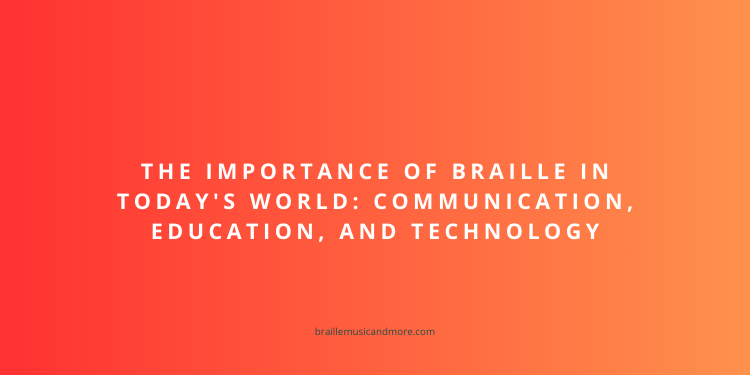Introduction
Like any other written language, Braille is an equally important language today. Braille is regarded as a crucial element for people who are visually impaired to communicate, read, learn, and connect to their communities.
Various enduring aspects make Braille an invaluable method. It’s critical to recognize this tactile script’s enduring strengths in order to appreciate its ongoing relevance.
Braille is still a valuable tool for many people, even with technological advancements; it offers a special and necessary means of information access, effective communication, and active participation in society and education for those who are visually impaired.
In this blog, we will highlight the importance of Braille in today’s world and its impact on communication, education, and technology. Let’s start.
How Does Braille Help The Blind?
Braille is a lifeline for those who do not have eyesight. It helps them with a form of communication that is not dependent on sight. Blind people, by tracing their fingertips on a series of raised dots, can read letters, words, and other literary works. They can now express themselves, interact with the world, and obtain information in ways that would otherwise be difficult, thanks to this tactile system.
What Is Braille Communication?
Braille communication is the process of using a braille system to convey and receive information. In contrast to the written language in a traditional format, braille communication uses a grid of raised dots where each of the grids represents either a letter, a number, or an entire word. People can decipher these patterns through touch, which makes it possible for them to independently participate in written communication.
How Is Braille Used?
Braille has a wide range of uses that facilitate communication for visually challenged people. Braille is used for reading books and labeling products, among other things.
Additionally, Braille is used on signage, enabling people with vision impairments to navigate public areas independently. Furthermore, people are empowered to recognize and operate household products like food and medication on their own thanks to Braille labels.
Braille Technology
In recent years, many advancements have been introduced to Braille technology that has expanded the horizons of Braille’s accessibility. Electronic braille displays are now available that help blind individuals to read the contents digitally in Braille. These advanced technologies can convert text from a digital device into the characters of Braille.
Braille For The Visually Impaired
For people who are visually impaired, Braille is more than just a skill. It opens their way to education and the workplace. People who can read and write in Braille can attend college lectures, work in a variety of workplaces, and participate in society. Learning Braille promotes self-sufficiency and independence.
How Long Does It Take to Learn Braille?
Learning Braille is an essential skill for the visually impaired, but it can be a question in your mind: how much time does it take to learn Braille? So, the duration of learning Braille varies from person to person based on their age, IQ level, previous literacy skills, and the progress of the learning process. Usually, if an individual is provided with a supportive learning environment where he can practice the learnings consistently, they can become efficient in Braille within a couple of months.
How Does Braille Work?
Understanding how Braille works includes the recognition of patterns of raised dots following six dot cells. Through tactile perception of this dot pattern, readers can recognize numbers, letters, and even musical notation. Braille functions by converting text into a form that is tactile and understandable through touch. Blind people can now read and write independently thanks to tactile literacy, which acts as a bridge to the information age.
Is Braille Hard to Learn?
Understanding Braille is like learning any new skill; it takes time and effort. That being said, it’s a common misconception that learning Braille is tough. Effective Braille learning can be achieved by people of all ages with the correct tools, encouragement, and support. Because Braille is tactile, it stimulates the sense of touch, which makes learning with it intuitive and memorable. The path to learning Braille requires perseverance and constant practice.
Learning Braille has two drawbacks because of its individualized nature. Few qualified teachers can frequently give students the individualized attention necessary to assure precision and ease in Braille. There is a dearth of educators with the necessary training to instruct Braille. Learning Braille is not as easy as learning print due to a lack of resources. Visually impaired people are not typically accommodated in school architecture or other aspects of the learning environment.
Conclusion
In conclusion, Braille is the most significant tool for blind and visually challenged people. It facilitates communication, education, and integration into a technologically advanced world. In this blog, we briefly discussed the role of Braille in communication, education, and technology. For more, you can go through our website, and access the services we provide.







